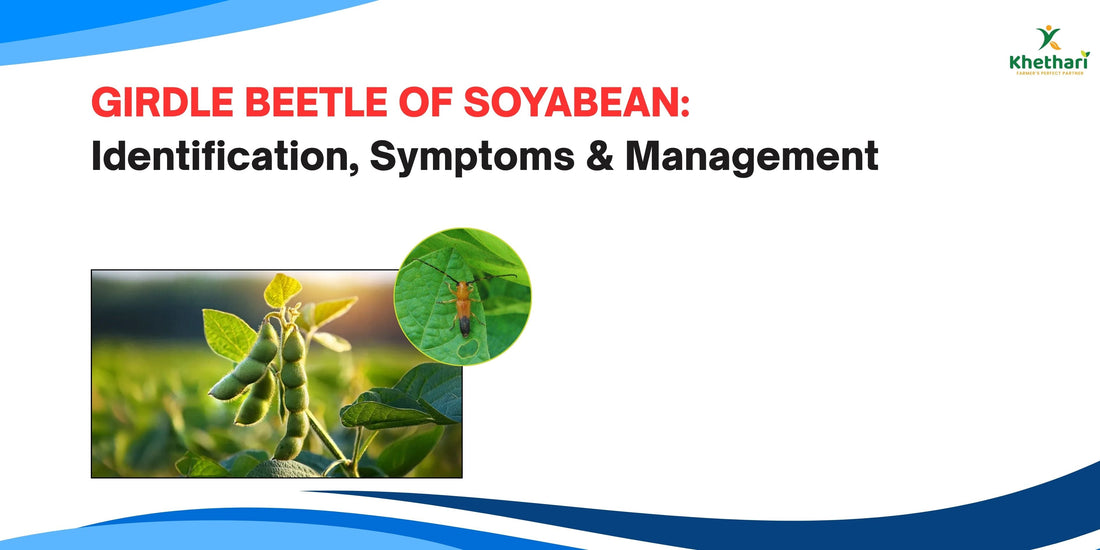
GIRDLE BEETLE OF SOYABEAN: Identification, Symptoms & Management
1. Pest Overview
Scientific Name: Migdolus fryanus (primary), belongs to the family Cerambycidae (Longhorn beetles).
Common Names: Girdle Beetle, Longhorn Stem Borer, Soybean Stem Borer.
Morphology and Identifying Features:
Adults:
- Cylindrical, elongated body, usually 1–2 cm long.
- Color ranges from dark brown to black, sometimes reddish-brown.
- Characteristic long antennae, often longer than the body.
- Strong mandibles for chewing plant tissues.
Larvae:
- Creamy-white, C-shaped, soft-bodied grubs with a hard brown head capsule.
- Body length of mature larvae: 15–25 mm.
- Burrow into stems and feed internally, creating tunnels called galleries.
Life Cycle and Reproduction:
- Eggs: Laid singly or in small clusters in cracks of stems or plant debris.
- Larvae: Bore into stems, feeding on the vascular tissues, weakening the plant.
- Pupae: Pupation occurs inside the stem tunnels or in the soil near the plant base.
- Adults: Emerge from stems or soil; lifespan ~2–3 weeks.
- Generations: Typically one to two generations per season, influenced by temperature and humidity.
2. Host Range
Primary Host: Soybean (Glycine max).
Secondary Hosts: Occasionally attacks other leguminous crops like cowpea, green gram, pigeon pea, and sometimes dicotyledonous plants.
Crops Commonly Affected in Region:
- Soybean is the most susceptible.
- Secondary legume crops in crop rotation fields may serve as alternate hosts.
3. Symptoms & Identification
Visible Damage Symptoms:
- Girdling of stems: Adult beetles and larvae chew the stem externally or internally, forming weak points.
- Wilting and yellowing of leaves, especially in branch tips.
- Premature pod drop and stunted plant growth.
- Stem breakage, especially during windy or rainy conditions.
Signs of Infestation:
- Exit holes (small round holes) on stems from emerging adults.
- Tunnels or galleries visible when stems are split.
- Larvae can sometimes be seen inside hollowed stems.
- Presence of frass (sawdust-like excrement) near the stem base.
Crop Stage Most Affected:
- Vegetative stage to early pod-filling stage.
- Damage during flowering and pod development can significantly reduce yield.
4. Economic Impact
Yield Losses:
- Girdle beetle infestations can reduce yields by 15–25%, depending on infestation severity.
- Severe larval tunneling weakens the plant, causing lodging and harvest losses.
Quality Reduction:
- Pod and seed development is compromised, affecting seed size and viability.
Seasonal and Regional Prevalence:
- Common in central and southern soybean-growing regions of India.
- Peak activity occurs during monsoon and post-monsoon periods, when soil and crop moisture are high.
5. Monitoring & Forecasting
Pest Scouting:
- Inspect soybean fields weekly from vegetative to early pod stage.
- Look for wilting branches, stem cracks, frass, and exit holes.
Traps and Indicators:
- Light traps attract adults at night.
- Pheromone traps are experimental but promising for early adult detection.
- Mark fields where beetles emerge to target localized control measures.
6. Integrated Pest Management (IPM)
A. Cultural Practices
- Crop Rotation: Rotate soybean with non-legume crops to reduce pest buildup.
- Sanitation: Remove and destroy infested stems or crop debris post-harvest to eliminate larvae and pupae.
- Planting Time: Adjust sowing dates to avoid peak adult activity.
- Resistant Varieties: Use tolerant soybean varieties where available.
B. Mechanical and Physical Control
- Handpicking: Effective for small fields with low adult populations.
- Light Traps: Use at night to attract and kill adults.
- Stem Removal: Cut and destroy heavily infested stems before larvae pupate.
C. Biological Control
- Predators: Encourage birds, predatory beetles, and ants that feed on larvae or adults.
- Parasitoids: Certain parasitic wasps attack larvae inside stems.
- Entomopathogenic Nematodes (EPNs): Can be applied to soil to target larvae before pupation.
D. Chemical Control
Foliar Sprays: Insecticides such as imidacloprid, thiamethoxam, chlorantraniliprole may be applied.
- Follow recommended dosage and safety instructions.
- Target early adult stage for maximum effectiveness.
Seed Treatment: Systemic insecticides protect seedlings from early larval attack.
Precautions:
- Avoid repeated use of the same chemical class to prevent resistance.
- Apply when beetle populations reach economic threshold levels.
7. Prevention & Advisory Tips
- Maintain clean fields and remove old plant residues.
- Avoid continuous soybean cultivation in the same field.
- Conduct weekly scouting for early detection.
- Integrate cultural, mechanical, biological, and chemical methods to manage populations effectively.
- Use farmer-friendly charts or pictorial guides for easy identification.
8. Farmer Advisory Notes
- Identification: Learn to recognize adult beetles, larvae, exit holes, and stem tunneling.
- Early Action: Treat lightly infested areas early; avoid waiting for widespread damage.
- Safety: Always wear protective gear during chemical application.
- Documentation: Keep field notes of beetle occurrence to plan future crop rotations and management strategies.
- Visual Aid: Illustrations of adult beetle, larval stage, and stem damage improve field recognition.
✅ Key Takeaways for Farmers & Extension Officers:
- Girdle Beetle attacks mainly stems, causing wilting, lodging, and yield loss.
- Regular monitoring and early intervention are critical.
- IPM approach combining cultural, biological, mechanical, and chemical methods is the most effective and sustainable.

